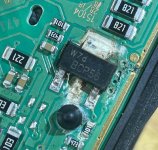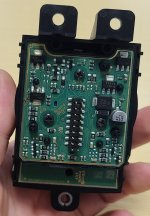Yes, this module is mounted in the center console between the vehicle seats with the side of the pcb facing downwardly so it is not clear how liquid would have gotten onto that side of the pcb from a spill, but that is what I am trying to determine.
Could the corrosion be just from a couple instances of liquid exposure, as opposed to just humidity itself causing it? There is a second same transistor nearby (not shown in the picture) that has the same thing - heavy corrosion on the collector terminals.
That is the real issue I am trying to determine and get input on - was this caused by liquid spills that crept under the center console top and somehow got onto the bottom of the board, or would it have to have been some longer term exposure such as from humidity over the course of a couple summers, or something else?
The reason it matters is because the dealer is asserting that it is customer (my) fault and not a warranty item. From my standpoint, I don't recall any instances of spills, but there might have been one or two. If it is my fault then I'm willing to pony up the large sum for the replacement part and labor, although even then I have to wonder about it being essentially a design flaw if a couple of spills could cause that underneath the console top.
My problem is that I don't see or have any more evidence of it being my fault than either a manufacturing or design problem. Moreover, before they even looked at it they mentioned that these cars have that problem not infrequently.
I do have some electrical test equipment, but the part is at the dealer. Unless they agree to somewhat split it with me, I might just tell them to give it back and I'll try to reflow the connections or even replace the $.20 transistors. Would be better than the 100x module cost and 300x labor cost they want to charge me!
More thoughts? You guys are being helpful.







